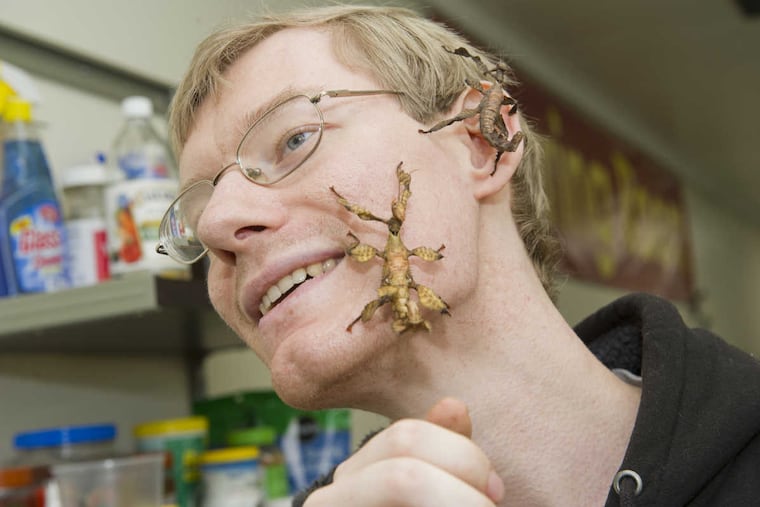Philly's Insectarium gets a massive overhaul

Like some of the creeping, crawling creatures housed inside of it, the Philadelphia Insectarium is going through a metamorphosis, and on Friday the museum will emerge from a cocoon of construction equipment and "wet paint" signs new and improved.
The 25-year-old museum had a humble start as a small display in the storefront window of Steve Kanya's exterminating business in a former American Legion hall on Frankford Avenue in Holmesburg. Over the years, the popularity of the informal exhibit led Kanya, now the chairman of the Insectarium's board of directors, to expand his collection and turn the space into a full-blown bug museum.
Now, after months of planning and a year of construction, Kanya and CEO John Cambridge are set to unveil a top-to-bottom renovation of the hall, an update of its educational materials and a brand-new butterfly pavilion, one of the largest of its kind in the country. "We made an effort to create the most diverse arthropod zoo on the East Coast, debatably in the United States, but there's a couple places in Arizona that really have got their game together," Cambridge says.
Cambridge's modesty is admirable, but the Insectarium is nothing to sneeze at (though some of the insects are — more on that later). The live displays on the second and third floors of the building are home to a stunningly large and diverse collection of insects, arachnids, reptiles, amphibians, and fish.
There are cockroaches from nearly every corner of the world — from the common pest species to more exotic ones. Take the selectively bred yellow variation of an African roach that looks like a gold coin with legs. Or, death's head roaches with thorax markings that look like a tiny human face.
"Each individual has a different look to them," says Wlodek Lapkiewicz, the museum's Living Colonies director. "There's one we've seen that looks like it has a vampire face, with two little teeth sticking out."
Simandoa cave roaches also have a home in the Northeast Philly Insectarium; they are extinct in the wild and now can only be found in captive populations.
Other terrariums hold foot-long centipedes, scorpions that glow under UV lights, boldly colored poison dart frogs, various species of praying mantis, and a leaf-tail gecko whose skin color and pattern so closely resemble tree bark that even Lapkiewicz needs a few minutes to locate it.
In one corner of the third-floor room is the museum's petting zoo, where visitors can let millipedes, mantids, and stinger-less whip scorpions crawl over their hands and arms. The sensation can be a little creepy, but depending on the bug, the scent is downright pleasant. Seriously, it smells delicious. Whip scorpions are also called vinegaroons, Kanya explains, because when they feel threatened they release acetic acid, the same chemical that gives vinegar its pungency.
At another exhibit, Lapkiewicz pulls out one of the Insectarium's other fragrant residents, the two-striped stick insect. "They release a chemical that makes you sneeze," he says, holding out the specimen that he just manhandled up to my face. It's a bit like sniffing fresh ground pepper, and while my nose starts to tingle, I manage not to sneeze the bug right out of Lapkiewicz's hand.
"I'm used to it, but some people will sneeze a whole lot, so it's a good defense against predators," he says.
On top of updating the live exhibits, the Insectarium crew overhauled the informational displays and education materials as part of the renovation. "We've brought the education level from grades K through five to K through grad school," Cambridge says. "And we now have the resources and materials for grade-specific tours."
Younger (or at least smaller) visitors can climb through a see-through plastic tunnel that puts them right in the middle of the iguana habitat, letting them watch the lizards up close, while more advanced entomology buffs can marvel at the enormous mural that catalogs some of the specialized limbs and other body parts bugs have evolved to help them skitter around, burrow in the dirt, or grab their meals. And everyone, no matter one's age or grade level, can have fun with what Cambridge says is the world's largest ferrofluid fountain: Visitors manipulate powerful magnets that control the flow of liquid to show how Monarch butterflies similarly follow the Earth's magnetic field to guide their migration. The fountain is one of several cool set pieces in the new 7,000-square-foot butterfly pavilion, where visitors can mingle with thousands of exotic butterfly species, wander through a 40-foot-long tunnel of live moss, and watch newly metamorphosed butterflies emerge from their chrysalises and prepare their wings for flight.
The bugs and interactive displays are amazing, but the Insectarium's greatest strength is its staff. Kanya, Cambridge, Lapkiewicz, and every other employee I met can rattle off their insect wards' Latin names and talk at length about their biology and behavior as if they were telling stories about old friends. Their passion for insects is obvious, and after transforming a simple storefront display into a state-of-the-art museum they're ready to get to work on the fun part: turning us all into fellow bug lovers.
Philadelphia Insectarium and Butterfly Pavilion, public opening Friday; regular hours: 9 a.m.-5 p.m. Monday-Sunday, 8046 Frankford Ave., $16 (general admission); 14 (seniors and students); $13 (children 3-13); free (children under two), 215-335-9500, www.phillybutterflypavilion.com.